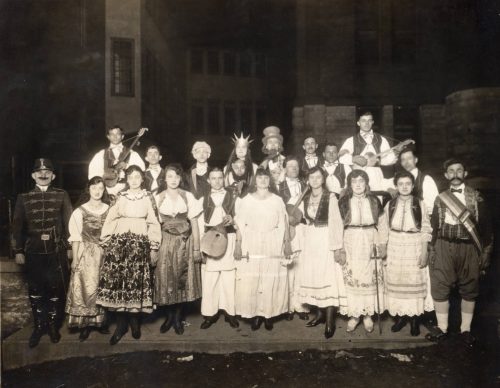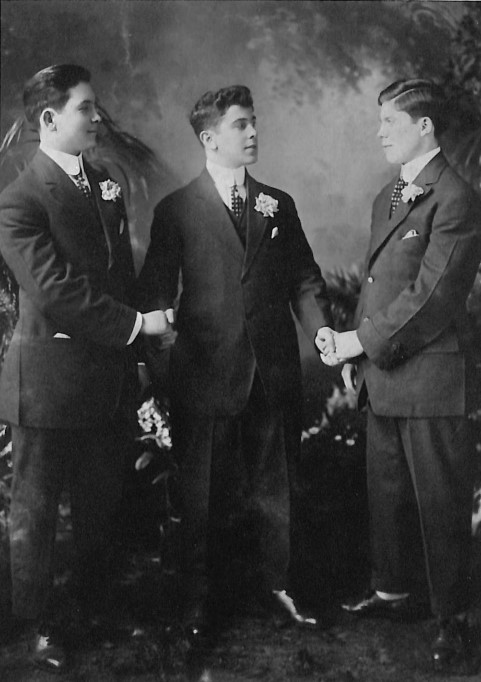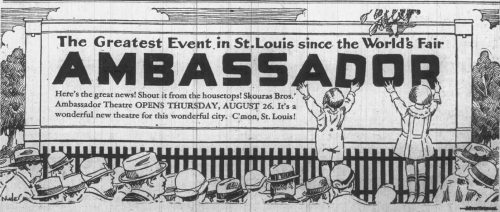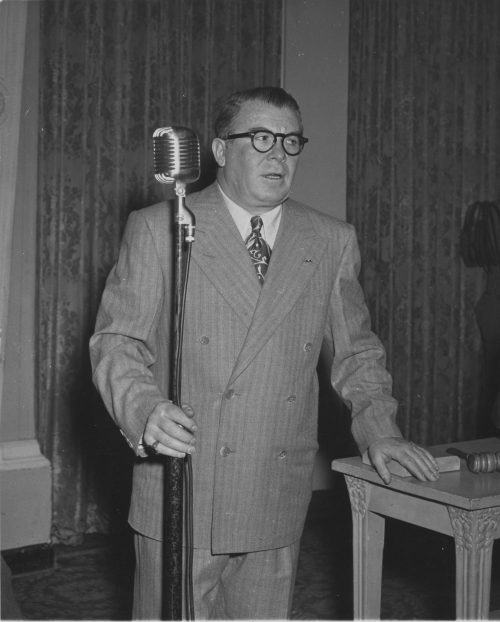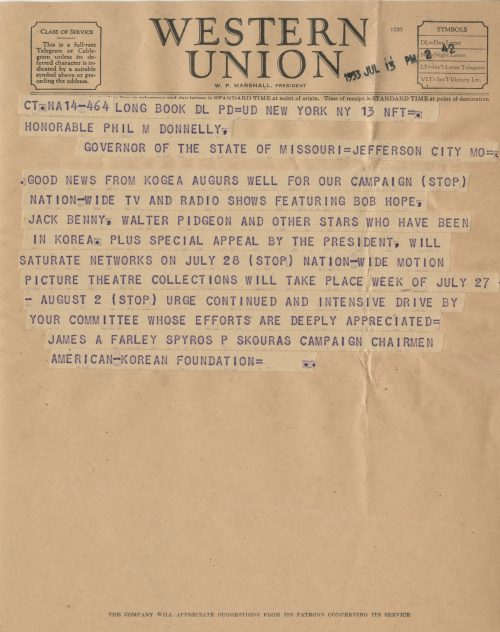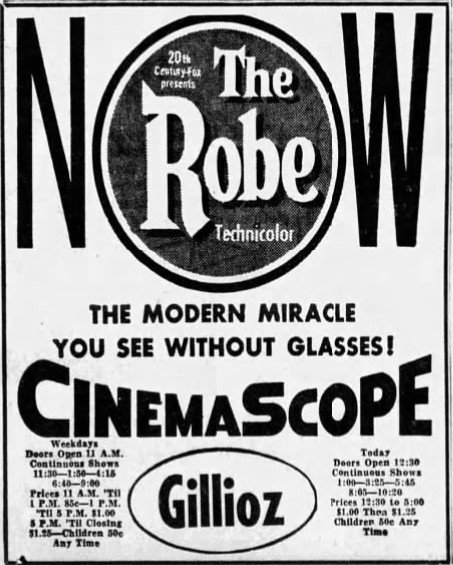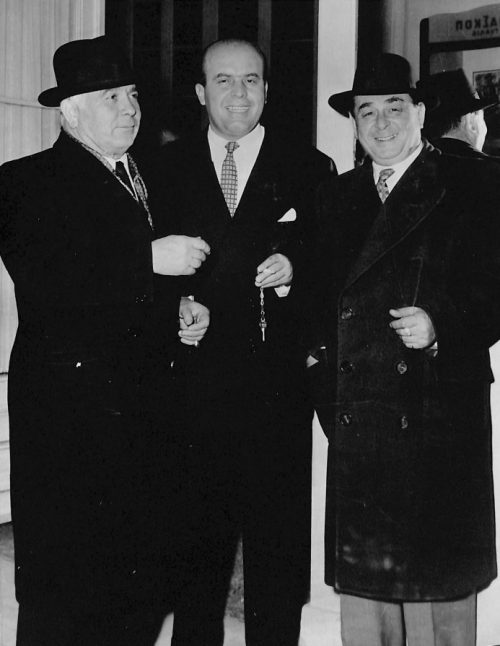![Skouras Brothers George Skouras, Charles Skouras, and Spyros Skouras, ca. 1950s. [Courtesy of the Department of Special Collections, Stanford University Libraries]](https://historicmissourians.shsmo.org/wp-content/uploads/2024/08/Skouras-Brothers-500x400.jpg)
Skouras Brothers
Introduction
Originally from Greece, the Skouras brothers, Charles, Spyros, and George, immigrated to St. Louis, Missouri, as teenagers. In St. Louis they owned and managed several movie theaters during the years when films were becoming a popular and profitable entertainment industry. The Skouras brothers’ business grew beyond St. Louis, and they became respected film executives in the mid-twentieth century for major motion picture companies such as Warner Brothers Pictures, Paramount, 20th Century Fox, and United Artists.
Childhood in Greece
Charles, Spyros, and George Skouras were all born in Skourochori, Greece. Charles, the oldest, was born in 1889; Spyros followed in 1893, and George in 1896. Their family had ten children in total, and their father, who worked as a shepherd, struggled to provide for them all. To survive, the family allowed their four boys to work for other people. Demetrios, the oldest brother, took charge of the family farm, while Spyros, Charles, and George crossed the Atlantic Ocean to the United States between 1908 and 1911 to find better work.
Skouras Brothers Arrive in St. Louis
After surviving a month-long ocean journey with nothing to eat but olives and bread, the Skouras brothers arrived in the United States, passing through Ellis Island in New York before making their new home in St. Louis. In the early twentieth century, St. Louis was the fourth-largest city in the United States with many jobs for immigrants. The brothers quickly found work serving drinks, washing dishes, and selling popcorn in a movie theater.
In an interview later in life, Spyros Skouras recalled, “We worked for sixteen hours, for two hours we wanted to go and come to the room where we slept on top of each other. Those were hard years, but I wish I could live them again because I was young. Ah, if it were youth twice!” The brothers saved money by limiting what they spent. They walked to work instead of paying for public transportation and only paid to go to vaudeville shows, movie theaters, and amusement parks on Sundays.
Olympia: A Game-Changing Venture
By 1913, the Skouras brothers had saved $3,500 in a joint bank account. Fortune soon smiled upon them when a friend helped them invest their money in a new movie theater project called Olympia. Despite conflicts with their first business partners, the Skouras brothers found success with Olympia and soon opened several movie theaters in St. Louis.
Much of this success was driven by their decision to add unique features to their theaters, such as matinees (daytime movies) for younger audiences, concession stands, and even small orchestras to accompany silent films. Prior to 1927, many movies did not have sound, so offering music during the silent films was a hit. By 1925, the brothers had an investment in nearly every significant theater in St. Louis, including the Ambassador Building, a $6-million, 17-story, air-conditioned structure housing the monumental Ambassador Theater.
Film Executives
Success, however, did not come without challenges. During the Great Depression in the 1930s, many people were out of work. This meant they could no longer afford to spend on entertainment such as movies. As a result, the Skouras brothers’ St. Louis theaters struggled. Hoping to change course, the brothers took part in a large merger of film and theater companies with Warner Brothers Pictures. The merger made Spyros, Charles, and George nationally known film executives. In the 1930s they began a lengthy climb up the ranks in the film industry, first with Warner Brothers, then Paramount and later with Fox West Coast Theaters, a company that managed more than 500 theaters in the United States. Charles later served as president of National Theatres, while George served as president of United Artists Theatres.
Spyros is credited with making Fox Entertainment much more profitable. In a historic merger, he led the creation of 20th Century Fox. Spyros became president of the company, serving in that role from 1942 to 1962. While he was president, 20th Century Fox produced several films that tackled hard subjects such as racism, anti-Semitism, and mental illness. His influence also led to the discovery of then relatively unknown actress Marilyn Monroe, as well as production of the 1963 epic film Cleopatra, starring Elizabeth Taylor.
Family & Philanthropy
The Skouras brothers were not only businessmen but also humanitarians. During Nazi Germany’s occupation of Greece in World War II, Spyros played a crucial role in the Greek War Relief Association (GWRA), providing $5 million in cash and $7 million in food, clothing, and medical supplies. He lobbied relentlessly in Washington, DC, and in London to lift blockades of Greece by the Allies fighting against Germany so that the Greek people would not suffer as much from shortages of food and other necessities. During the Korean War, Spyros assisted with humanitarian efforts as campaign chairman for the American-Korean Foundation. In the 1950s, led by Charles Skouras, the brothers made significant financial donations to build Saint Sophia Greek Orthodox Cathedral in Los Angeles.
"Movies Are Better Than Ever!"
In the 1950s, when the rise of television posed a threat to the film industry, Spyros championed the rallying cry that “Movies are better than ever!” He helped lead efforts to make movies more competitive with television by improving motion-picture technology. This led to CinemaScope, a revolutionary technology involving a wide, curving screen and special sound equipment that improved the experience of seeing movies in theaters. The Robe was the first movie to showcase CinemaScope.
Legacy
As Spyros Skouras attempted to revitalize film through CinemaScope, his brothers were at the ends of their respective film executive careers. Charles Skouras lived to see the construction of Saint Sophia Greek Orthodox Cathedral, but he died a few years later in 1954. Around the same time, George Skouras helped form Magna Theatre Corporation, which eventually had a major role in the distribution of Todd-AO films, notable for their sound quality and widescreen format. He passed away in 1964.
At nearly seventy years of age, and following pressure from the film studio in the wake of the financial mismanagement of the film Cleopatra, Spyros Skouras stepped down as president of 20th Century Fox in 1962. He remained chairman of the board until 1969, but he no longer held an active role in the day-to-day operations of the company. For the rest of his life, he served as chairman of another business, a fleet of ships called Prudential-Grace Shipping Lines. He died in 1971.
The Skouras brothers are remembered for their extraordinary passion and vision that forever changed the way people experience stories on the big screen. Their rise from poor brothers in a Greek village to Hollywood film industry executives continues to inspire people who dream of succeeding in business.
Text and research by Surabhi Ganguly
References and Resources
For more information about the Skouras Brothers’ lives and careers, see the following resources:
Society Resources
The following is a selected list of books, articles, and manuscripts about the Skouras Brothers in the research centers of The State Historical Society of Missouri. The Society’s call numbers follow the citations in brackets.
Articles from the Newspaper Collection
- “Ambassador Theatre Section.” St. Louis Star. August 25, 1926. p. 1-16.
- “From a Busboy in St. Louis Hotels to Head of $60,000,000 Film Company.” St. Louis Globe-Democrat. May 4, 1942. p. 1C, 3C.
- Irwin, Virginia. “Milestone Award for Spyros Skouras.” St. Louis Post-Dispatch. April 10, 1958. p. 3F.
- “Koplar Details Warner Deal for Skouras Holdings.” St. Louis Post-Dispatch. October 17, 1931. p. 6A.
- Niemeyer, Harry. “Charlie Pleased the Patrons.” St. Louis Post-Dispatch. January 2, 1944. p. 3C.
- Niemeyer, Harry. “Charlie Skouras—Greek Genius of the Theater.” St. Louis Post-Dispatch. December 26, 1943. p. 1C
- Soren, Noelle. Windows to Wonderland: Cinespace Creations by the Boller Brothers, Architects. Tucson, Arizona: MGP Publishing, 1999. [REF F529 So68 v. 1 & v. 2]
- Howard A. Rusk Papers (C3981)
The papers of Howard A. Rusk, who developed the field of rehabilitation medicine, include correspondence, photographs, writings, publicity clippings, photographs, speeches, and other materials documenting his work in the field. - Joseph Pulitzer Papers (S0060)
The Papers of Joseph Pulitzer span the years 1897 to 1958, with the bulk of the material dated between 1925 and 1955. Microfilm reel 19 features correspondence between Pulitzer and Spyros Skouras. - Phil M. Donnelly Papers (C2151)
The collection is largely comprised of governor’s files and departmental correspondence, including between Donelly and Spyros Skouras concerning the American-Korean Foundation. Some newspaper clippings on various topics and index cards on state employees are also included. Also included are 24 scrapbooks with newspaper clippings pertaining to Donnelly’s time spent in office.
Outside Resources
These links will take you outside the Society’s website. The Society is not responsible for the content of the following websites:
- NEO Magazine
This website is hosted by NEO Magazine and features an article by Ilias Chrissochoidis entitled, “The most influential Greek since Alexander the Great?: A reappraisal of Spyros P. Skouras.” - Online Archive of California
This website is hosted by the Online Archive of California and features the finding aid and other materials related to the Spyros P. Skouras Papers housed at Stanford University. - Spyros P. Skouras (1893-1971)
This website is hosted by Stanford University and curated by Ilias Chrissochoidis. It features information and documents related to the life and career of Spyros Skouras.

